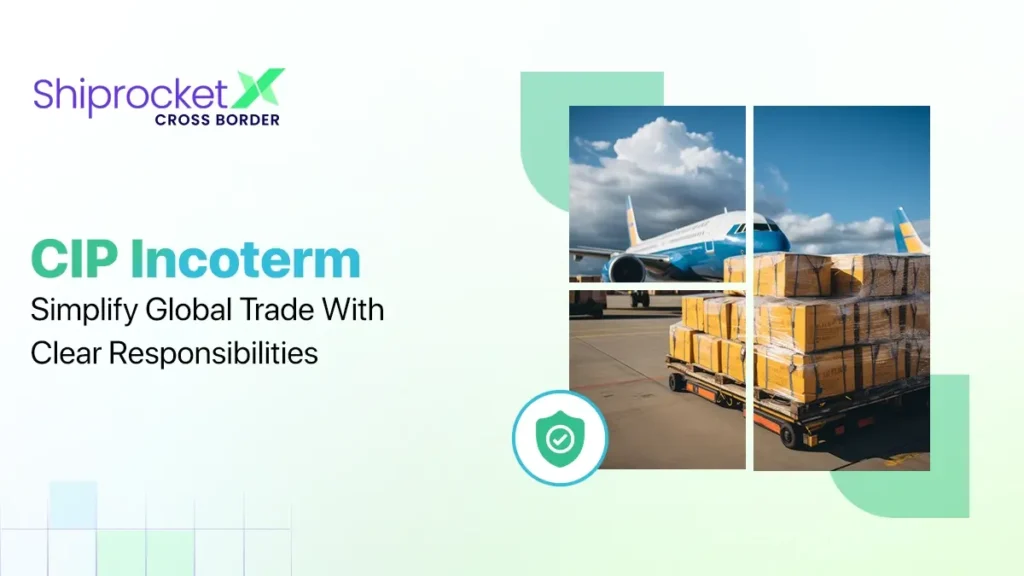CIP Incoterm: Know the Trade Terms Streamlining Global Trade
- CIP Incoterm: What is it?
- How CIP Incoterm Facilitates Trade?
- Understanding the Scope of CIP Incoterm Coverage
- Exploring Additional Coverage Under CIP Incoterm
- Determining Insurance Requirements for CIP
- Transportation Modes Eligible for CIP Incoterm
- Seller’s Responsibilities under CIP Incoterm
- Buyer’s Obligations within the CIP Incoterm Framework
- CIP Insurance: Ensuring Comprehensive Coverage for International Shipments
- Conclusion
Have you ever wondered who bears the risk of the goods shipped? More importantly, at what point does the risk shift to the seller? These are important questions that need answers before a consignment is shipped. The carriage and insurance paid to (CIP), is a trading practice that answers all of these questions. It tells us up to what point the risk is taken by the seller and when it is transferred to the buyer.
The CIP is a practice that makes boundaries clear while trading. It enables an easier understanding of the responsibilities involved and the resources needed. It largely helps in optimising and unifying international trade.
This blog will help you gain a better understanding of CIP incoterm, how it facilitates trade, its scope, and more.

CIP Incoterm: What is it?
Insurance has been a concept and practice in trading for several years. CIP is a practice when a seller assumes the burden of paying freight and insurance to ship and deliver goods to a party appointed by the seller at a specified location. The risk of losing and damaging goods during shipping is transferred onto the buyer when the goods are delivered to the carrier or designated person.
CIP is separate from cost, insurance, and freight (CIF). CIP is comparable to CIF. CIF is an agreement that is used in maritime and commodity trade. Under the guidelines of CIP, the seller is obligated to insure the entire goods for 100% of the overall contract value. Additional insurance costs must be borne by the buyer.
The term CIP was published by the International Chamber of Commerce in early 2020.
How CIP Incoterm Facilitates Trade?
CIP is generally used in conjunction with the specified destination. For instance, CIP Delhi means that the seller will be obligated to pay for freight and insurance charges to Delhi. It holds true even for carriage paid to (CPT). Carriage or freight charges with CIP refer to transportation charges for any mode of transportation like sea, rail, road, inland waterway, and multimodal transportation.
For instance, let us consider a laptop manufacturing Company XYZ in Mumbai that wants to ship a container of their products to Vietnam. Under the CIP incoterms, Company XYZ will be responsible for all the costs incurred in freight and basic insurance until the delivery is made to the agreed-upon destination in Vietnam. Upon delivery, Company XYZ’s obligations are complete. The entire risk is transferred to the Vietnamese company from that point forward.
Understanding the Scope of CIP Incoterm Coverage
Vastly accepted internationally, CIP is one such incoterm that is curated by the International Chamber of Commerce (ICC). It strongly enables the regulation of shipping costs in a business sale. It needs the seller to pay not just freight charges but also basic insurance in sending the goods to the buyer at the agreed-upon location. Upon arrival, the risk and loss involved become the buyer’s responsibility.
Exploring Additional Coverage Under CIP Incoterm
CIP is now a globally accepted standard and the seller will only be obligated to purchase the basic amount of insurance coverage to ship their consignment to the agreed upon destination. The buyer will be asked to cover any additional insurance costs that protect it from other risks. This is necessary as the buyer will be bearing heavy losses if the shipment is lost or damaged due to reasons beyond the basic insurance coverage.
The buyer might also ask the seller to give extra insurance coverage. Based on the bargaining positions of the two, they can negotiate for the seller to bear all these additional costs as well.
Determining Insurance Requirements for CIP
The insurance to be purchased by the seller is standard. The seller must purchase 110% of the contract value as insurance. Any additional insurance is the buyer’s burden.
Transportation Modes Eligible for CIP Incoterm
Understanding the right incoterms is crucial while dealing with the complexities of international trade. The CIP incoterm gives the sellers and buyers flexibility in their manner. Now, let us understand what modes of transportation are eligible for the CIP incoterm.:
- Air freight: When it comes to high-value and time-sensitive shipments, air freight is the most popular choice. Through CIP, the seller will cover the transportation charges and basic insurance until the designated destination. This ensures that the goods will be protected during transit and it gives the buyer a sense of security.
- Sea freight: Another common mode used under the CIP incoterm is sea freight. Irrespective of shipping a full-load container or less than a container load, the CIP incoterm makes sure that the seller will pay for all transportation and insurance costs until the destination port. It is effective cost-wise for bulk shipments.
- Rail transportation: A reliable and affordable solution for both cross-border and inland shipments is rail transportation. Through the CIP incoterm, the seller will be liable for transportation of the goods to the destination with basic insurance. Rail transport serves heavy and voluminous cargo well.
- Road transport: This conventional method is still extremely reliable for short-distance and landlocked areas. CIP suits road transport as well. This mode is most suited for door-to-door deliveries as they provide direct access to the final destination.
- Multimodal transportation: CIP is very flexible for several transportation modes. The biggest benefit of CIP is that it bodes well for several transportation modes. It enables seamless transitions between multiple modes of transportation. It enables efficient delivery of your goods.
- Combined transportation: In several cases, shipping goods involves multiple transportation modes. CIP allows the easy integration of different transportation modes. It also covers the insurance throughout this journey.
Seller’s Responsibilities under CIP Incoterm
Here are the seller’s responsibilities under the CIP incoterm framework:
- They should provide goods, commercial invoices, and the required documents.
- They should obtain export licenses and handle other customs formalities.
- They should ensure proper packaging and marking for exports.
- They should ensure pre-carriage and delivery to the destination agreed upon.
- They should provide proof of delivery.
- They should cover the expenses of any pre-shipment inspection if required.
- They should also cover the cost of delivery and loading charges at the named place of destination.
- Ensure all goods in transit have all-risk insurance coverage.
Buyer’s Obligations within the CIP Incoterm Framework
Since we have discussed the seller’s responsibilities, let’s dive into the buyer’s obligations under CIP incoterm. Buyers should:
- Comply with the payment terms as given in the sales contract
- Pay any duties associated with imports and manage other formalities
- Cover the cost of any pre-shipment inspection if required
- Pay the cost of import clearance
CIP Insurance: Ensuring Comprehensive Coverage for International Shipments
CIP and CIF are two important incoterms that make insurance mandatory. In both of these cases, the seller will be responsible for obtaining cargo insurance. In case a buyer can obtain cheaper or better insurance options, CPT can be considered. Here, the seller will not be obliged to provide cargo insurance and the buyer will be able to get whichever insurance they prefer.
Conclusion
Carriage and insurance paid to (CIP) clearly state that the seller will be obligated to pay the freight charges and insurance while shipping goods to someone. They can choose the location where the goods must be delivered. The seller will also be responsible for providing basic insurance to cover the goods. It must be 110% of the total contract value. This practice is accepted worldwide. CIP is also extremely flexible. It caters to all forms of transportation mopeds. It also allows the same for multimodal and combined transportation modes. The ability of CIP is what makes it so widely accepted and used. It provides peace of mind to both the seller and the buyer.





